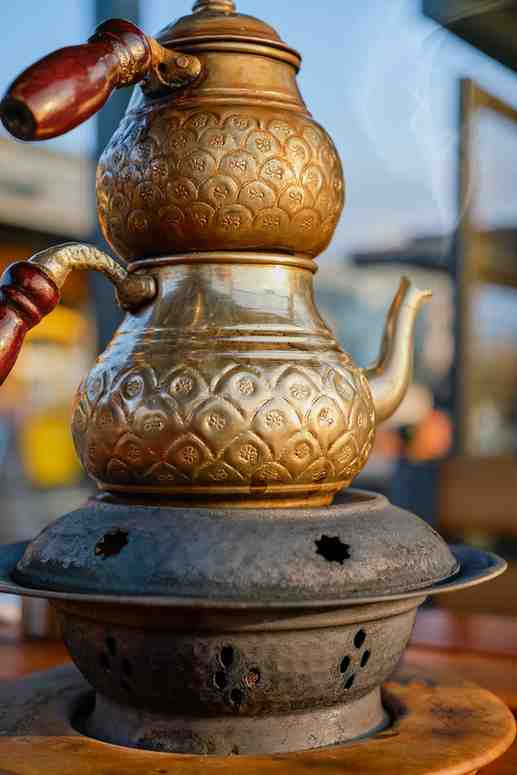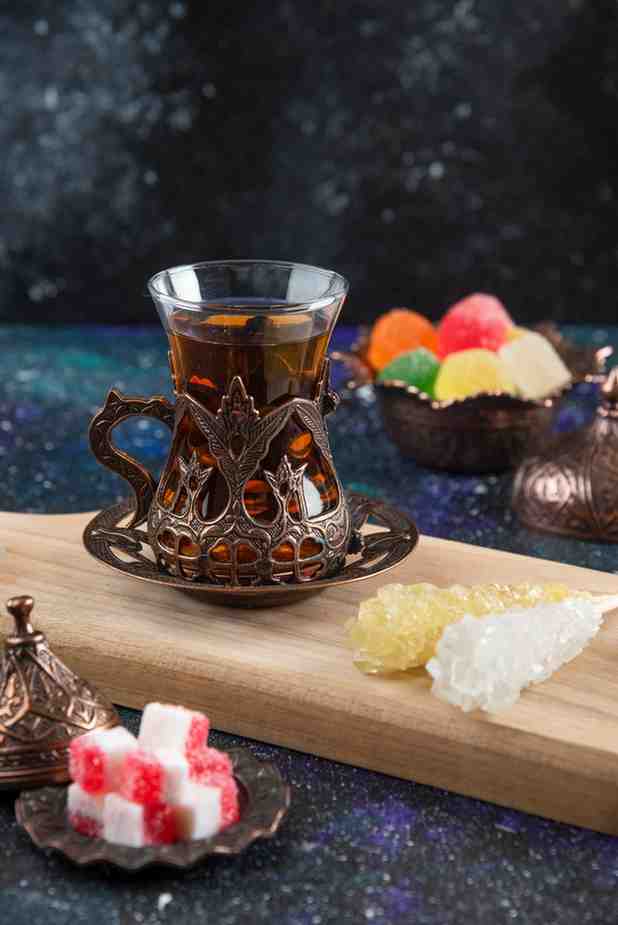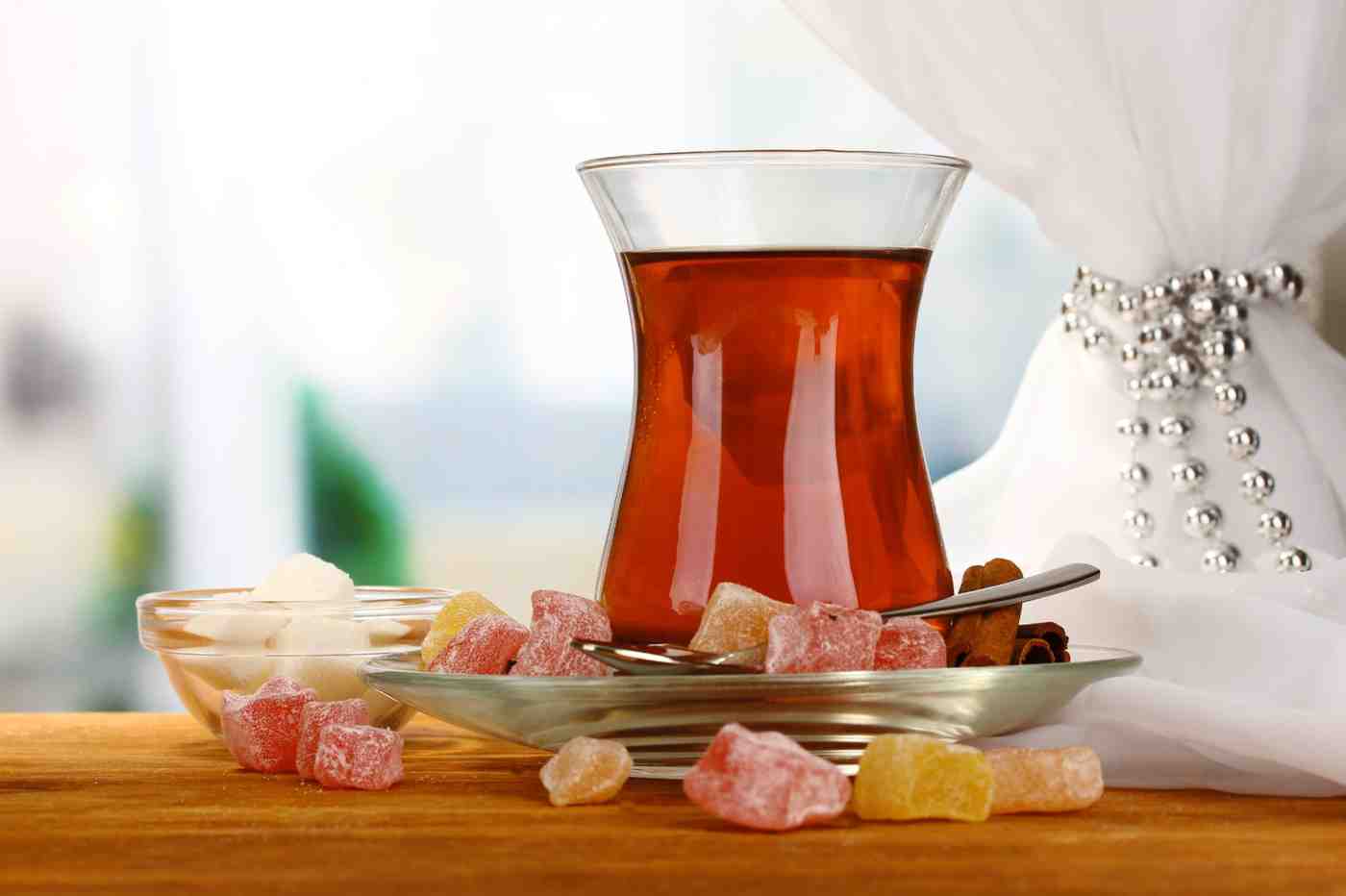Turkish tea, known locally as “çay,” is a fundamental part of Turkey’s cultural heritage. It symbolizes warmth, hospitality, and the sense of community that defines Turkish society. Drinking tea is not just about enjoying a beverage; it’s a social experience that connects people, whether in bustling city cafés or quiet village homes. A cup of tea is always present when conversations start, friendships deepen, and guests are welcomed.
- Integral to social gatherings, from casual chats to formal meetings.
- Reflects Turkey’s warm and hospitable culture.
- Often served to guests as a sign of respect and friendship.
The History of Turkish Tea
The history of tea in Turkey is surprisingly recent, yet it has become a national obsession. Unlike coffee, which has deep roots in the Ottoman Empire, tea gained popularity only in the 20th century. Its widespread appeal grew from both economic and cultural shifts, making it a staple in Turkish households.
Origins of Tea in Turkey
Tea arrived in Turkey during the late Ottoman period, but its cultivation began in earnest around the 1920s. Initially, the focus was on finding a local alternative to imported beverages. The government encouraged the growth of tea plants in the Rize region, along the Black Sea coast. The climate there proved perfect for cultivating high-quality tea.
- The first tea seeds were planted in Rize in the 1920s.
- Efforts to grow tea domestically aimed to reduce dependence on imported products.
- The Black Sea region, especially Rize, quickly became the center of Turkey’s tea production.
As the tea industry in Turkey flourished, it provided a new economic lifeline for the region. Farmers quickly adopted tea cultivation, and the beverage became more affordable for the average person. This affordability made tea a daily indulgence that soon became a part of Turkey’s social fabric.
- Domestic production made tea more accessible to all social classes.
- Became a popular alternative to the more costly Turkish coffee.
- Turned into a symbol of Turkish pride and self-sufficiency in the 20th century.
Evolution of Tea Culture
As tea became a household staple, it reshaped social customs. Offering tea to guests became a standard practice, a sign of hospitality and respect. The simple act of pouring tea turned into a ritual, shared between friends, family, and even strangers. This tradition is still alive today, where tea flows generously during any gathering, big or small.
- Tea became an integral part of hospitality, offered to every guest.
- Symbolizes generosity and openness in Turkish culture.
- Shared during moments of celebration, as well as quiet, reflective conversations.
Unlike other tea cultures, such as the British afternoon tea or Japanese tea ceremonies, Turkish tea is casual yet ever-present. It doesn’t require elaborate setups or strict rules. Instead, it invites a relaxed, communal experience where the emphasis is on togetherness and conversation.
- Consumed at all times of the day, from breakfast to late-night chats.
- Served in small tulip-shaped glasses that keep the tea warm.
- Encourages a sense of unity, creating a comfortable atmosphere for discussions.
Types of Turkish Tea
Turkish tea is most known for its black tea variety, but other types reflect regional diversity and preferences. Each variety offers a different taste experience, allowing people to enjoy Turkish tea in various forms.
Black Tea: The Staple
Turkish black tea is the most widely consumed type. It has a rich, full-bodied flavor and is typically brewed strong. The tea is served without milk, allowing its robust taste to shine. Unlike many Western teas, Turkish black tea is brewed using a traditional double-pot method that ensures a customizable strength and warmth.
- Known for its deep red color and bold flavor.
- Served in tulip-shaped glasses, showcasing its vibrant hue.
- Can be sweetened with sugar, though many enjoy it plain for its authentic taste.
The brewing process involves using a çaydanlık, a two-tiered teapot that allows the tea to be brewed strong in the top pot while hot water is kept in the bottom pot. This setup makes it easy for each person to adjust their cup of tea to their preferred strength, making it a versatile choice.
- Two-pot system: Ensures strong tea that can be diluted with hot water as desired.
- Customizable strength: Allows drinkers to adjust their tea from light to bold.
- Ideal for long conversations, as the tea stays warm for hours.
Regional Variations and Specialty Teas
Turkey’s diverse regions have developed their own unique tea traditions. Each area adds its own twist to the way tea is prepared and enjoyed. These variations highlight the rich cultural tapestry of Turkey, offering different flavors and experiences.

- Kıtlama Tea (Erzurum): A specialty in Erzurum, where tea is enjoyed by holding a sugar cube between the teeth and sipping the strong tea. This method creates a sweet contrast with each sip.
- Turkish Apple Tea (Oralet): A popular fruit-flavored tea, especially among tourists. It is sweet, refreshing, and often served hot or cold.
- Herbal Teas (Adaçayı): Sage tea, known as adaçayı, is widely consumed for its soothing and digestive properties, particularly in coastal regions.
These regional specialties offer an opportunity to explore different flavors beyond the classic black tea. They reflect the local customs and preferences, making each cup a journey through Turkey’s diverse culinary landscape.
- Regional variations cater to different tastes, from robust to sweet.
- Reflect local traditions and adapt to regional climates and ingredients.
- Offer a glimpse into the cultural diversity within Turkey.
The Traditional Turkish Teapot (Çaydanlık)
The çaydanlık, a unique double-stacked teapot, plays a key role in Turkish tea culture. It allows for the slow brewing of concentrated tea while keeping hot water ready for diluting the brew to the desired strength. This method is central to the Turkish tea experience, ensuring a warm, rich cup every time.
How a Çaydanlık Works
The çaydanlık consists of two pots: a smaller upper pot for brewing the tea and a larger lower pot for holding hot water. This setup makes it easy to adjust the strength of each cup by mixing concentrated tea with hot water.
- Upper pot: Holds the concentrated tea brew.
- Lower pot: Keeps hot water ready for diluting the strong tea.
- This method keeps the tea warm for longer periods, making it ideal for social settings.
Using a çaydanlık allows for a customized tea experience, as each person can decide how strong or light they want their tea. It also creates an opportunity for sharing, as a single brew can serve multiple people over an extended conversation.
- Perfect for social gatherings, as the tea remains warm throughout.
- Allows for a versatile drinking experience, catering to different preferences.
- A staple in Turkish homes, cafés, and tea houses.
Importance of Quality Water and Tea Leaves
The quality of water and tea leaves directly influences the taste of Turkish tea. Fresh, clean water enhances the natural flavors of the tea, while premium tea leaves ensure a rich, satisfying taste.
- Fresh water prevents unwanted flavors, providing a pure taste.
- Top brands like Çaykur produce high-quality tea leaves, preferred for their consistency.
- Proper brewing temperature extracts the best flavor from the leaves.
Choosing the right ingredients and maintaining the correct brewing technique ensures that every cup of Turkish tea offers the full, rich experience that people expect.
- Ensures a balanced flavor and aroma.
- Reflects the care and attention put into Turkish tea-making.
- Guarantees a memorable tea experience, whether shared with friends or enjoyed alone.
Brewing and Serving Turkish Tea

Brewing Turkish tea is both an art and a tradition. The process requires patience, precision, and the right equipment to create a perfectly balanced brew. Beyond preparation, the way tea is served plays a crucial role in the experience. Turkish tea is a sensory delight, with its deep red hue, fragrant aroma, and warmth—served in elegant, tulip-shaped glasses.
How to Brew Authentic Turkish Tea
Brewing Turkish tea involves a specific method that has been refined over generations. The process uses a traditional double-pot teapot, known as a “çaydanlık,” to ensure that the tea is brewed to perfection. Follow these steps to achieve a rich, flavorful cup of Turkish tea.
Step-by-Step Brewing Method
- Prepare the Çaydanlık:
- Fill the bottom pot of the çaydanlık with fresh cold water and place it on the stove.
- Add loose-leaf Turkish black tea to the top pot (typically, 1 tablespoon of tea per cup).
- Heat and Brew:
- Heat the water in the lower pot until it reaches a gentle boil.
- Pour a small amount of boiling water over the tea leaves in the upper pot to help them bloom.
- Combine and Simmer:
- Place the upper pot on top of the lower pot, allowing the steam from the boiling water below to gently brew the tea.
- Let it simmer for about 10-15 minutes, ensuring that the tea becomes rich and aromatic without overboiling.
- Serve with Hot Water:
- To serve, pour the brewed tea from the top pot into a tulip-shaped glass until it is one-third full.
- Dilute the concentrated tea with hot water from the lower pot, adjusting the strength to your preference.
- Tip: A perfect Turkish tea should have a deep red color, known as “tavşan kanı” or “rabbit’s blood.”
- Tip: Avoid stirring the tea in the glass as it can cloud the brew. The right balance of tea and water should blend naturally.
Common Mistakes to Avoid
Even though the brewing process is straightforward, there are a few common mistakes that can impact the quality of your tea. By avoiding these errors, you can ensure a perfect cup every time.
- Overboiling the Water: Boiling water for too long can make the tea taste bitter. Use water that has just reached a boil for the best flavor.
- Using Low-Quality Tea: High-quality loose-leaf tea ensures a rich, aromatic brew. Cheaper, lower-quality teas often lack the depth of flavor.
- Rushing the Steeping Process: Letting the tea steep for the right amount of time (10-15 minutes) is crucial for extracting the full flavor. Rushing this step can result in a weak brew.
- Incorrect Ratio of Tea to Water: Finding the right balance between concentrated tea and hot water is key to achieving the perfect strength. Too much concentrate can make the tea too strong, while too little can result in a bland taste.
By paying attention to these details, you can master the art of brewing Turkish tea, ensuring a consistent, enjoyable experience every time.
Turkish Tea Etiquette and Serving
In Turkey, serving tea is an expression of hospitality and respect. The way tea is offered and enjoyed carries social significance, making it more than just a simple refreshment. Understanding Turkish tea etiquette can enhance your experience and allow you to appreciate the cultural nuances behind every cup.
Serving Turkish Tea in Tulip-Shaped Glasses
Tulip-shaped glasses, known as “ince belli” in Turkish, are the preferred choice for serving Turkish tea. These small, curved glasses are designed to keep the tea hot while allowing the drinker to appreciate its rich color.
- Keeps Tea Hot: The narrow shape at the top helps retain heat, ensuring each sip remains warm.
- Showcases the Color: The transparent glass allows the deep red hue of the tea to shine, adding to the sensory experience.
- Comfortable to Hold: The glass’s curved design fits comfortably in the hand, making it easy to sip slowly.
Serving tea in these glasses is a matter of pride in Turkey. It reflects the host’s care for their guests and adds a touch of elegance to the tea-drinking experience.
Social Norms Around Tea Consumption
Drinking tea in Turkey is more than just a personal habit—it’s a social tradition that connects people across different walks of life. Tea is a constant companion during conversations, whether in homes, workplaces, or local tea houses.
- Tea as a Gesture of Welcome: Offering tea to guests is one of the first acts of hospitality. It shows warmth and a willingness to share time together.
- The Art of Pouring: Hosts often pour the tea for their guests, symbolizing their role as a caretaker and ensuring that each guest’s glass is never empty.
- Slow Enjoyment: Turkish tea is meant to be sipped slowly, not rushed. The process encourages a slower pace, inviting people to relax and enjoy the moment.
Comparing Turkish tea customs to other countries highlights the unique role it plays. Unlike England’s structured tea time or Japan’s formal tea ceremonies, Turkish tea is casual yet meaningful. It’s about creating moments of connection rather than adhering to rigid rules.
- Comparison with England: In England, tea is often served with milk and enjoyed during specific times of day. Turkish tea, however, is served plain and is suitable for any time, from morning to late night.
- Comparison with Japan: Japanese tea ceremonies are ritualistic, emphasizing precision and mindfulness. Turkish tea, in contrast, is about socializing and making guests feel at ease.
Health Benefits of Turkish Tea
Beyond its cultural significance, Turkish tea offers several health benefits. It is rich in antioxidants, which can support heart health and overall well-being. Moderate consumption can be a healthy addition to a balanced diet, providing both comfort and nourishment.
Antioxidants and Heart Health
Turkish black tea contains antioxidants, such as polyphenols, which help combat free radicals in the body. These compounds can reduce oxidative stress, potentially lowering the risk of chronic diseases.
- Supports Heart Health: Regular consumption of black tea is associated with improved cardiovascular health. It may help reduce bad cholesterol levels and improve blood vessel function.
- Boosts Immunity: The antioxidants in tea can also support the immune system, helping the body fend off illnesses.
- Aids Digestion: Drinking tea after meals is a common practice in Turkey, believed to aid digestion and soothe the stomach.
These benefits make Turkish tea a wholesome choice, combining both flavor and wellness in every cup.
Caffeine Content and Consumption Recommendations
While Turkish tea is less caffeinated than coffee, it still contains enough caffeine to provide a gentle boost of energy. Understanding how to balance tea consumption can help you enjoy its benefits without overdoing it.
- Moderate Caffeine: A cup of Turkish tea contains around 40-50 mg of caffeine, making it a milder alternative to coffee.
- Daily Intake: Drinking 3-4 cups per day is generally considered safe for most adults, providing a steady energy boost without jitters.
- Evening Relaxation: Many Turks enjoy tea in the evening, despite its caffeine content. The social and calming nature of tea time often outweighs the stimulating effects.

